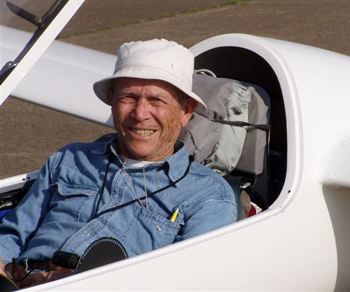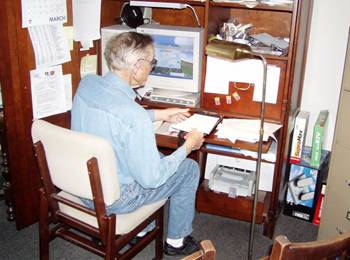 A
FLIGHT TEST EVALUATION OF
A
FLIGHT TEST EVALUATION OF
THE HP-18W SAILPLANE
by Richard H. Johnson
Testing a new incarnation of an old design.
(Soaring Magazine July 2003)
The HP-18 is a Dick-Schreder-designed all-metal 15 meter Racing Class sailplane that was offered as a kit during the 1970s and 80s. Why are we testing one now when we at the Dallas Gliding Association normally test newer production sailplanes? It is out of respect for Dick Schreder's memory and amazing design capabilities. The HP-18 was one of his most successful designs, with about 110 kits produced. Many are still flying today, and drawings and parts are still available from Bob Kuykendall's HP Aircraft Company.
Udo Rumpf of Ontario, Canada, is also a talented designer and homebuilder, and he recently rebuilt an HP-18 in a manner that would have made Dick Schreder proud of his design classic. Not only did Udo really smooth and upgrade the airframe, but he added winglets of his own design. He also modified the wing airfoil to his own laminar design, using an epoxy-microballon mixture and carefully contoured profile templates. When he offered to bring his super HP-18W to Texas for a mini flight test, we could not refuse the opportunity to see what a carefully crafted HP-18 could really do.
The workmanship and detail quality of our test sailplane were outstandingly good. It was fitted with an excellent forwardhinged canopy of Udo's design - he even made his own Plexiglas canopy, with optics second to none! Its white polyurethane painted exterior surfaces were beautifully smoothed, polished, and waxed.
The wing area is about 110.7 square feet, and the aspect ratio measures about 21.9. The wing surface waviness was very low, averaging well below the .004" limit that I believe to be needed to achieve extensive low-drag laminar flow on sailplane wings. The machined aluminum wing spar appeared to be very strong. Udo was a professional machine designer and builder by trade, and the details of the sailplane construction reflect that. The retractable main wheel is a 5.00 x 5" unit equipped with a hydraulic disc brake, which functioned well. The aft end of the fuselage is equipped with a solid rubber tail wheel. A Tost towhook was installed on the main landing gear support tubes. Because of the aft-mounted tow hook location, and also because the sailplane was ballasted to near its aft CG limit, aero towing was quite demanding.
Udo apparently prefers flying his HP-18 heavy with its CG well aft. When it arrived at Caddo Mills, the sailplane's empty weight was about 744 lbs with winglets, instruments, two batteries, parachute, and about 106 lbs of steel plate ballast bolted onto the fuselage deck behind the main wing spar. To provide his desired aft CG, Udo installed about 10 lbs of lead plates bolted into the tail fin roots. Since Udo is about 38 lbs heavier than I am, and I was to do the flight testing, he agreed to remove 4.5 lbs of the tail ballast. Even then I was a bit surprised when I later performed balance measurements and found the sailplane's CG to be as far back as about 0.437 MAC (mean aerodynamic chord). Dick Schreder recommended that .40 MAC should be the HP-18's aft limit (Ref. F).
AIRSPEED CALIBRATION
Our HP-18 airspeed system used a pitot tube mounted in the fuselage nose ventilation air inlet and fuselage nose side orifices for its static source. Inside a hangar and out of the wind, we calibrated the sailplane's Winter airspeed indicator by carefully comparing its readings to our calibrated reference meter. Although the Winter ASI appeared to function well with little hysteresis, its measured errors were unusually large. It read close to 5 kts too low at 120 kts CAS, the upper end of our planned flight-test range! Measured airspeed indicator instrument error data are shown in Figure 2. It is likely that the HP-18's ASI had been accidentally damaged at some time in the past - it may have been dropped, or had its bellows over-pressured and strained. Since it otherwise functioned well, and we now had it calibrated, we could still use it during our coming flight-testing.
We later performed the airspeed system flight calibration. A 9,000' tow was made with the sailplane equipped with a trailing bomb static reference that I deployed after tow release out the canopy side window. A Kiel tube reference pitot was temporarily taped to one side of the canopy. The flight test calibration was then performed by flying at steady indicated airspeeds ranging between 40 to 120 kts, and comparing my master reference indicated airspeeds to those of the sailplane. Those test data were then used to compute the HP-18's airspeed system errors (Figure 3). Those errors appear to be quite high for a modern sailplane. The HP was actually flying about 2 kts slower than its true calibrated value near its 40 kt IAS stall, increasing linearly to about 10 kts slower than calibrated at 120 kts IAS. The cause of these higher-than-true readings is almost certainly from the ASI static sources being located on the fuselage nose sides where too much suction pressure exists. A much more accurate static source would be on the aft fuselage sides. The ASI system errors discussed here are not to be confused with the ASI instrument errors discussed above - they are entirely separate.
Fuselage side static pressure orifices are subject to clogging when flying through rain. For that reason a pneumatic switch of some kind should be installed, teed into the sailplane's static pressure line, so that the pilot can switch to an alternate static source if clogging occurs within the basic static pressure line. Venting the alternate static pressure source to the cockpit usually provides a fairly good static reference pressure.
SINK RATE TEST FLIGHTS
For these tests we had to wait until the atmosphere became relatively calm with little vertical air motion or horizontal wind shear at flight test altitudes. It had been a windy and cloudy winter sea son in Texas this year, but finally on the 23rd of March the atmosphere became acceptably clear and calm for sink-rate testing. I made two 12,000' tows to measure the HP-18's sink rates at various airspeeds and flap settings. 38 sink rate points were measured during those two flights; and they are shown plotted in Figure 4. The corresponding L/D data from these 2 flights are shown in Figure 5.
Despite my relatively high 8.07 psf wing loading, a minimum sink rate of about 112 ft/min is indicated at 42 kts. To achieve that low minimum sink rate with that wing loading and only 15 meters of wingspan is remarkable. Apparently Udo's winglets really work well! The best L/D appears to be about 40: 1, over the 60 to 68 kts calibrated airspeed region, and that is excellent for a 15-meter sailplane.
WING OIL FLOW TESTS
Udo had installed full-span .3 mm high zigzag turbulator tapes on the HP's wing bottom surfaces at the .70 chord location, and similar turbulator tapes on the top surfaces at the .60 chord location. An oil flow test flight was conducted at 70 kts IAS, and the results looked very good. No separation bubbles were shown, and the airflow on both the upper and lower wing surfaces appeared to be laminar all the way back to the turbulator tape locations. Udo used an original airfoil, and verified its performance with VisualFoil computer software by Patrick E. Hanley. Nice job Udo! (Ed. Note: The pictures of oil flow tests were provided by Udo Rumpf. Picture 1, Picture 2 and Picture 3.)
WING SURFACE WAVINESS MEASUREMENTS
We made chordwise waviness measurements of the HP-18's wing top and bottom surfaces at 7 spanwise stations along each wing using a standard 2-inch long wave gage. The wing surface waves were very small, averaging a little less than .0025" peak-to-peak, and that is excellent. Only two places on the wing top surfaces near the tips did our measurements exceed .003 inches. Those waviness measurements are for peak-to-peak magnitudes - from valleys to peaks. Those measured data are shown plotted in Figure 6.
GENERAL CHARACTERISTICS
Udo's HP-18's elevator and wing flap controls connect automatically upon assembly. Only the ailerons needed to be connected manually, but that was easily done before the turtle-deck was installed. The ailerons were somewhat stiff, likely because their hinge lines were well encased with Mylar seals on both their top and bottom surfaces. The cockpit was enclosed by an excellent forward hinged canopy system, and the Plexiglas canopy itself had very good optics. The cockpit is well sized and comfortable, the controls easily reached, and the rudder pedals are adjustable in-flight.
The visibility from the cockpit was very good - I appreciate being able to see the tow line when flying an aero tow because that adds to flight safety. When test-flying the HP-18, I was a bit disturbed by its lack of stick-free pitch stability. I did all my test flying with the pitch trim set to full nose down, even when flying at 40 kts! In my opinion there were two reasons for this observed lack of pitch stability: the V-tail ruddervators have no camber at their trailing edges, and I was flying tail-heavy with the CG too far aft. In my opinion, flying with the CG at about .437 MAC is really too far aft for safe and comfortable flying.
Even with the CG well aft, the HP-18 handled fairly well, but not great. The controls all worked well, but the rudder was weaker than typical for conventionally tailed sailplanes. Udo has modified the original Schreder side-mounted control stick to a better conventional center stick configuration, as most HP-18 owners have done. Its stall characteristics are not bad, with almost no tendency for the sailplane to drop a wing during my low-airspeed maneuvering tests. The wing airfoil was modified from the original Wortmann FX67 -150 section to Udo's own design, and it appears to perform well. A water ballast tank was included in each wing spar box, but I did not test that feature.
The HP-18's 90-degree trailing edge flaps worked fairly well, but were a bit less effective than I recall from my HP-13 flying days. Obviously, my relatively high 8 psf wing loading degraded their effectiveness during my landings, and I needed to make lower approaches.
Although the early spring thermals during the Caddo Mills flight-testing period were fairly weak, I was able to soar the HP-18 for over 2 hours on one rather cloudy evaluation flight. I thought that that it thermalled well.
For more information about the HP-18, including parts and drawings, go to Bob Kuykendall's HP Aircraft web site: http://www.hpaircraft.com, or Schreder Sailplane Designs web site: http://www.soaridaho.com/Schreder/. For information on the software Udo used to verify his airfoil ideas, see http://www.hanleyinnovations.com.
 SUMMARY
SUMMARY
In my opinion the HP-18 sailplane kit was an attractive sailplane-building project for many pilots in the past, and I understand that some unfinished kits and parts are still available. Rebuilding one, as Udo did, is an opportunity for the talented and dedicated homebuilder to own a high-performance sailplane without spending big bucks.
Thank go to Udo Rumpf for bringing his fine sailplane to be used for our flight tests, and to the Dallas Gliding Association for providing both the hangarage and the high aero tows needed to accomplish it. Thanks also to Southwest Soaring's manager Doug Workings, and his Caddo Mills tow pilots who did the excellent towing.
REFERENCES
References A through F are Dick Schreder's series of six articles "Building the HP-18" in Soaring Magazine, March through August, 1976.